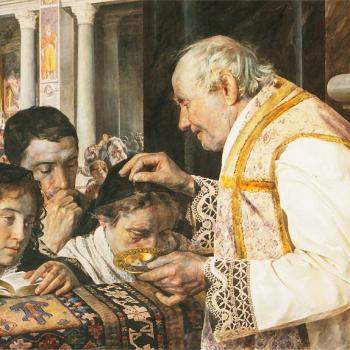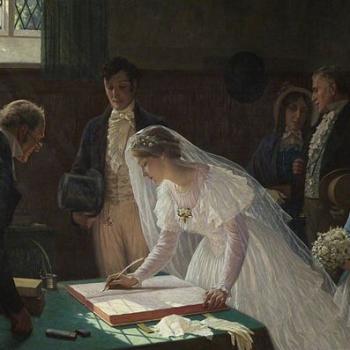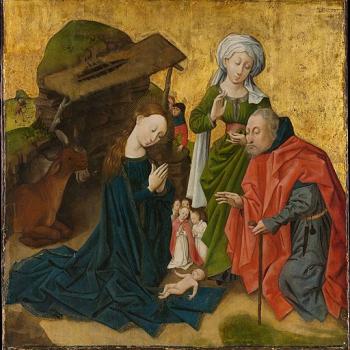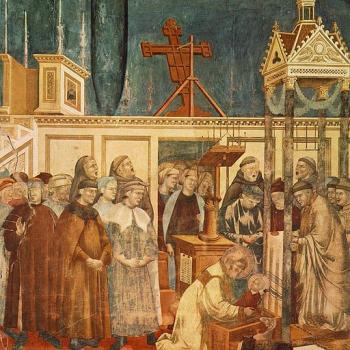Recently, I was asked to write an essay from my Secular Franciscan region’s quarterly newsletter, similar to the one I wrote a few months ago. This time I chose the topic of structural racism. I just submitted the final draft and I will post it here when it appears. But this one went through a couple major drafts, and I want to salvage for use here an argument that got dropped at my editor’s recommendation. (Like any good writer, I do not want anything to go to waste!)
The idea I wanted to develop was to use the lives of two famous Franciscan saints–St. Louis, King of France, and St. Junipero Serra, found of the California missions–to illustrate how structural racism can shape the lives and actions of even good people towards wrong ends. I got the idea of using the two because during the protests this summer, statues of Louis and Junipero Serra were targeted by demonstrators. By considering their lives, my goal was to help my fellow Franciscans see how their lives could be shaped by broader social and cultural forces into supporting racist structures, even if they themselves were not personally racist. In retrospect, I realize that I also wanted to go the other direction, and use the ideas of critical race theory to help us understand in context the lives these two men, and those of other Catholic saints whose lives contain actions that we recognize today as evil. I have never liked the attempts I have seen to whitewash these elements out of their lives. Indeed, I started thinking about this after reading a comment on FB in which a very conservative commentator tried to justify the actions of St. Louis:
The Jews were punished during King Louis’ reign because of their excessive usury, the practice of charging excessive interest upon money lending. Their Talmuds (religious texts of the time) were burned because a Jew who had converted to Christianity brought charges against them for blasphemy regarding Jesus and Mary. Such vile things were written that the texts were considered outrageous for the time period. A debate, a trial, ended in an agreement that the Jew’s talmuds would be destroyed and the texts rewritten. Jews wore identifying garments just as many Muslims elect to do so today.
On the other hand, it seems unproductive to simply dismiss him as an anti-Semite and remove him from memory. Historical persons, like the past, are more complicated than that.
But, anyway, this argument was complicated, and after working it out, my post was too long even though the argument was underdeveloped, so my editor sent it back to be reworked. I reproduce the text below, with the hopes of spurring a discussion about this idea. I think this approach, though underdeveloped in what I wrote, is useful for both understanding our past and ourselves.
To help us understand the ways in which good people can still be enmeshed in racist structures and have their actions distorted by them, I want to reflect on the lives of two great Franciscan saints: St. Louis, king of France, and St. Junipero Serra, founder of the California missions. Both came to prominence this summer when demonstrators, having targeted statues of Confederate heroes (which were not erected to celebrate Southern heritage but as symbols of white supremacy), also called for the removal of statues of St. Louis and St. Junipero Serra. I do not want to discuss the complicated question of whether they should be honored with public statues; instead, I want to consider the parts of their lives that open them to criticism. Further, I want to do so by grounding them in the social structures they were part of.
During the Middle Ages, anti-Semitism was an accepted part of society. The world was divided between Catholics and the “Other”–Jews within and Muslims without–who were regarded as both inferior and a threat. Discrimination, ostracism and open violence against Jews were the norm across Western Europe. St. Louis, during his reign, was an active participant in this anti-Semitism. His most notorious act was to order the burning of thousands of copies of the Talmud, after show trials in which rabbis were forced to defend it against charges of blasphemy. He also forced Jews to wear distinctive badges; authorized magistrates to compel Jews by force to attend “missionary sermons”; ordered the seizure of their property as part of anti-usury campaigns; and late in his reign planned for the forced expulsion of the entire Jewish population of France.
The Spanish colonization of the New World followed the conquest and subjugation of the millions of indigenous inhabitants. In Mexico and South America great civilizations were thrown down and everywhere the native population was reduced to second class status. They had some defenders but they were generally regarded as inferior, so much so that they were regarded as natural infants, children who needed to be educated and disciplined by the superior Spaniards. Their native culture and social structures were suppressed, and the Spaniards did not hesitate to use force to reshape them into imitations of Europeans. Junipero Serra shared in this sense of superiority. He clearly loved the native peoples of California, and at times strove to protect them from the rapaciousness of Spanish governors. But at the same time he accepted uncritically Spanish imperialism and the new order being imposed on an unwilling population. He viewed the natives with paternalism, and he felt no compunction about using violence–manhunts for runaways, floggings, shackles–to discipline his “wayward children.”
In the case of both saints, we see how the social structures around them led to acts that we cannot and should not approve of. These parts of their lives are sometimes whitewashed by their defenders, or we are told that we should not judge them by modern standards. But this is not acceptable: violence, oppression and discrimination are always and everywhere wrong, and we must accept that sinful acts are committed even by saints. But what we can do is try to understand the social forces that led these men to do these things–to be accomplices in anti-Semitism and racism, respectively.
It is relatively easy, with hindsight, to look back on the lives of historical figures and see how they were led astray. Since we are not part of their societies we can see the faults within them and the impact they had on their lives. But, if we can see this in the lives of saints, we also need to see this in our own lives. This is harder, and more uncomfortable, because it requires that we acknowledge, not what historical figures did, but what we, our families, our friends, our Church, our society, our government, are doing now. We need to look around ourselves and acknowledge the ways in which we have become accomplices in racism.
The one advantage that we have over both St. Louis and St. Junipero Serra is that the oppressed and marginalized are no longer silent. Today Blacks and other minorities have voices, and they are in a position to tell us–in ways that the Jews of the Middles Ages or the indigenous peoples of the New World could not–how they are affected by the social structures that the white majority has created. Our bishops have called on us to hear what they are saying:
As Christians, we are called to listen and know the stories of our brothers and sisters. We must create opportunities to hear, with open hearts, the tragic stories that are deeply imprinted on the lives of our brothers and sisters, if we are to be moved with empathy to promote justice. (Open Wide Our Hearts)
If we open our hearts and really listen, we can finally see structural racism for what it is, and take the first steps towards racial justice.













